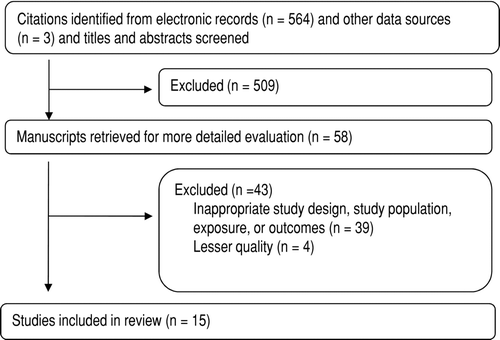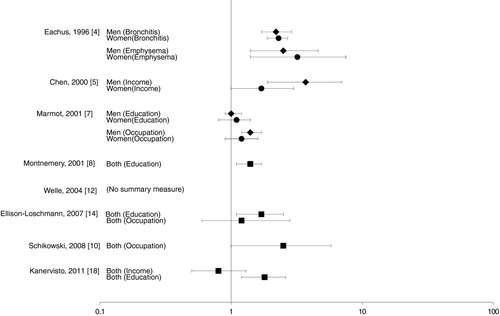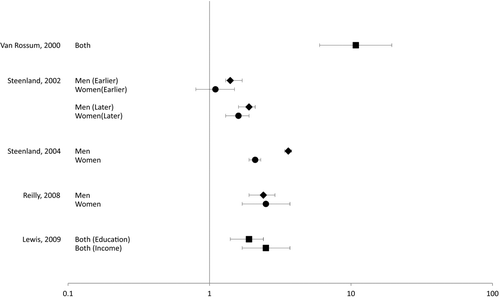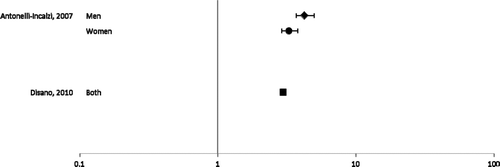Abstract
Background. Along with age and sex, socioeconomic status is one of the most powerful determinants of health. We conducted a systematic review to examine the consistency and magnitude of the association between socioeconomic status and COPD health outcomes to determine the potential impact of SES disparity on the COPD population. Methods. Electronic databases to October 2011 were searched for studies of adults who had or were at risk for COPD that quantified an association between a measure of socioeconomic status and at least one COPD health outcome. Two authors independently reviewed studies, assessed study quality, and for eligible studies, extracted data. Results. Regardless of the population, socioeconomic status measure or COPD outcome examined, with few exceptions, consistent significant inverse associations between socioeconomic status and COPD outcomes were found. Most studies found that individuals of the lowest socioeconomic strata were at least twice as likely to have poor outcomes as those of the highest (range from no difference to 10-fold difference). Conclusions. Social and economic disadvantage appears to have a significant consistent impact on COPD mortality and morbidity. These findings point to the need for public health strategies and research to address socioeconomic status disparity in individuals with COPD.
| Abbreviations | ||
| COPD: | = | chronic obstructive pulmonary disease |
| SES: | = | socioeconomic status |
Introduction
Inequalities in health among groups of different socioeconomic status (SES), as commonly measured by education, occupation, and/or income, constitute one of the main challenges for clinicians and public health. Along with age and sex, SES is one of the most powerful determinants of health with people of lower SES often experiencing worse health outcomes than those of higher SES. Evidence-based strategies that address SES disparity need to be developed and implemented; however, this resource intense process rarely occurs. This may be due to a lack of awareness of the substantial impact of SES disparity and the benefits that could be obtained by addressing it. Such impact is likely specific to different diseases and outcomes.
Chronic obstructive pulmonary disease (COPD) is a common, progressive condition associated with significant mortality and morbidity (Citation1). Several studies have explored the association between SES and COPD in select populations, with many finding worse outcomes associated with lower SES, but the evidence has not been uniform. Disparity in COPD outcomes has been attributed to smoking, occupational exposures, prenatal exposures, air pollution and a number of other factors (Citation2).
An up-to-date systematic review exploring the relationship between SES and COPD outcomes across different populations, SES measures, and health outcomes would determine if a consistent association exists, its direction and its magnitude. The results of such a review would either justify and point to the need for investment into further research and strategy development/implementation or indicate that resources would be better used elsewhere. Investment, if warranted, in addressing SES disparity would be of particular importance to individuals with COPD because medical approaches, thus far, have provided limited benefit (Citation1). Therefore, we conducted the current study to examine the association between SES and COPD health outcomes.
Methods
Study identification
With the aid of a medical librarian, we used systematic methods to identify published observational studies that measured an association between SES and COPD health outcomes. To identify all relevant studies, we: (Citation1) electronically searched all English language studies in Medline, Healthstar and Embase from their respective inception dates until October, 2011; (Citation2) manually searched reference lists from included studies; (Citation3) conducted key author searches; and (Citation4) performed citation searches through the Web of Knowledge. This strategy was reviewed and approved by all investigators. We did not search the grey or unpublished literature. For further information on the search strategies employed please see Appendix I.
Study eligibility
Two investigators (AG, TD), not blinded to study authors or results, independently evaluated study eligibility and resolved differences by discussion until consensus was reached. To be included, studies had to focus on adults either diagnosed with or at risk for COPD and report an association between SES and at least one COPD health outcome. COPD outcomes were subdivided into three common areas of interest: the risk of developing COPD, COPD prognosis, and COPD health care utilization.
Data study quality and extraction
Two investigators (AG, TD) independently assessed study quality and extracted data. As there is no standardized quality scoring system for observational studies, reviewers assigned scores for components of quality based on the framework for assessing prognostic studies from the Evidence-Based Medicine Working Group (Citation3). Studies were checked to see if they had an appropriate, representative, and large enough sample of individuals, that follow-up was complete, and that objective and unbiased exposure and outcome criteria were used (for details, see ). The potential confounding variables that were adjusted for were also noted.
Table 1. Study quality and generalizability assessment
Using scores as a guide, reviewers excluded studies determined to be of lesser quality based on discussion until consensus was reached. Reviewers accepted, but documented, how authors determined diagnoses of COPD. A standardised spreadsheet was used to independently abstract data on study design, setting, dates, population, SES measure, and study outcomes. Authors of all included trials were contacted as necessary to clarify information.
Outcome measures
Any outcome measure that expressed an association between SES and COPD health outcomes was considered. Where possible, measures that compared COPD outcomes between the lowest and highest SES strata were obtained. In most cases, this was expressed as a relative risk, a relative rate ratio, or an odds ratio. Because it was anticipated that study populations, SES measures, and outcomes would vary widely, no meta-analyses were planned.
Association between SES and Outcomes across diseases
Studies that examined an association between SES and disease outcomes across more than one disease were reviewed a second time. Outcome measures across different diseases within (not between) studies were compared.
Sensitivity analysis
A review of the lesser quality studies was conducted to determine if their results were consistent with the main findings.
Results
Study selection
Initial searches identified 564 unique citations from electronic bibliographic databases and 3 original citations from other sources. Of those, 509 were excluded leaving 58 studies for a more thorough review. Most were excluded because they did not examine a relationship between SES and COPD outcomes or did not only study patients with COPD. Upon more detailed evaluation, 39 of the 58 remaining studies were found to have inappropriate study design, study population, exposure, or outcomes and 4 were of lesser quality, leaving 15 that met criteria for the current review () (Citation4–18). A detailed breakdown of study quality can be found in . The 4 lesser-quality studies all focused on small, non-population-based sample of individuals from either one location or a few related locations (Citation19–22).
Study characteristics
Summaries of the 15 included studies are provided in Tables , and . Only one of the studies focused on SES and COPD outcomes alone—the rest either examined SES as one of many exposure variables and/or examined SES disparity across multiple diseases. Studies were mainly set in North America and Europe, with one set in China. Most studies examined outcome measures in men and women separately, examined COPD according to difference diagnostic criteria (i.e., chronic bronchitis and emphysema), and/or examined more than one type of SES exposure. Thirty-one outcome measures were reported in total. After reviewing all of the studies, the decision to conduct meta-analyses was reconsidered, however, due to significant differences between studies it was decided not to proceed.
Table 2. Studies describing the association between socioeconomic status and the risk of developing COPD
Table 3. Studies describing the association between socioeconomic status and COPD mortality
Table 4. Studies describing the association between socioeconomic status and COPD Health Service Utilization
Overall association between SES and COPD outcomes
Twenty-three outcome measures demonstrated a significant inverse association between SES and COPD outcomes (Tables , , and and , 3, and 4). Additionally, 6 outcome measures demonstrated a non-significant inverse relationship (Citation5). Only one of the studies showed a non-significant direct relationship and none a significant direct relationship. Most relative outcome measures between the lowest and highest SES were 2-fold or more (range 0.8 to 10.8).
Prevalence and incidence of COPD
Eight studies examined an association between SES and risk of developing COPD as demonstrated by 17 outcome measures ( and ). Seven examined COPD prevalence and 1 COPD incidence in the general population. Education was used in 5 studies and income in 2. The majority of studies found individuals of the lowest SES to be significantly more likely to develop COPD than those of the highest. Relative outcome measures ranged from 0.8 to 3.7.
COPD mortality
Five studies, reporting 11 outcome measures, examined an association between SES and COPD prognosis ( and ). All explored COPD mortality, as recorded on death certificates, in the general population. SES was determined solely by level of education in two studies, education and income in one study, and occupation in the remainder. Except for one outcome, individuals of the lowest SES consistently had significantly higher mortality than those of the highest SES. Relative outcomes measures comparing the lowest to the highest SES strata ranged from 1.1 to 10.8.
COPD health care utilization
Two studies examined an association between income and rate of hospitalization for COPD ( and ). In both, there were significant inverse associations between income and rate of hospitalization with relative risks of ranging from 3.0 to 4.3.
Association between SES and outcomes across diseases
Seven studies compared associations between SES and disease outcomes across multiple diseases (). Two reported COPD incidence and prevalence, three COPD mortality, and two COPD hospitalizations. In four of the seven studies, the relative outcome measures were greater for COPD than the other diseases examined, with 95% confidence intervals that did not overlap. In the remaining three, non-significant trends favoured greater disparity in COPD.
Table 5. Comparison of the magnitude of the association between socioeconomic status and disease outcomes across various disease
Sensitivity analysis
Two of the lesser quality studies showed significant inverse associations between SES and COPD with relative measures ranging from 2.2 to 19.2 (Citation19,20), one showed both significant and non-significant inverse associations (Citation22), while the last demonstrated no association (Citation21). Thus their results appeared mostly consistent with the main findings.
Discussion
We conducted a systematic literature review of SES and COPD and found, with few exceptions, significant inverse associations between SES and COPD outcomes that were consistent across gender, age, and population and appeared uninfluenced by how COPD was diagnosed, the SES measure used, or the disease outcome studied. We also found that individuals of the lowest SES were at least twice as likely to have poor COPD outcomes as those of the highest SES. This suggests that eliminating SES disparity could have a greater impact than of any COPD medication currently available (Citation23). Furthermore, in studies that compared associations between SES and outcomes across several diseases, disparity was greater with COPD. These findings justify and point to the need for investment into further research and strategy development/implementation to address SES disparity in individuals with COPD.
The SES disparity we observed is consistent with a large body of literature demonstrating significant socioeconomic differences in morbidity and mortality (Citation24). This ‘wealth-health’ gradient has been well described across many diseases, populations, and settings, including countries with publicly funded health care systems (Citation25).
Previous literature suggests that the cause of disparity in COPD outcomes is likely multifactorial. Several potential mediating factors have been proposed such as smoking, occupational and prenatal exposures, air pollution, housing conditions, environmental exposures in childhood, and childhood respiratory infections (Citation2, Citation26). Smoking has been of particular interest because of its strong association with socioeconomic status (Citation27).
Other potential factors, such as a history of tuberculosis and burning of biomass fuels in the home, are more common to developing countries. Identifying factors responsible for SES disparity has been challenging due to their significant overlap with each other (e.g., many people who work in low-paying occupations also smoke) and lack of available, detailed, comprehensive exposure data that can tease out important associations. This is complicated by the likelihood that different factors play different roles in different patient populations. For example, Steenland et al. found occupational class to be associated with a high prevalence of bronchitis in men but not women—likely because men had occupations where they were more likely to be exposed to occupational pollutants (Citation9, Citation28). In the current review, adjusting for a large number of factors –such as smoking and occupational pollutants—appeared to attenuate the magnitude of the association between SES and COPD outcomes, suggesting that those factors (and/or others correlated with them) were partially responsible (Citation9,Citation14).
Although all the studies demonstrated a significant inverse relationship between SES and COPD outcomes, there were 4 that also reported non-statistically significant associations.[7,9,14,18] There are several reasons why results from these studies may not have reached statistical significance. First, they might have used SES measures that were not applicable to the populations they studied. For example, as mentioned above, occupational class seems to have less correlation with COPD outcomes in women because, compared to men, they are less likely to have jobs with exposure to occupational pollutants (Citation28).
Second, they may have studied populations that had little variation in SES which made differences difficult to detect. This may have been the case for the study by Marmot et al. which followed government workers between ages 35 and 55 years (Citation7). Finally, adjusting for a number of explanatory variables correlated with SES (for example, smoking), could have removed variation due to SES that would have otherwise been observed (Citation9,Citation14).
The significant and consistent inverse associations we observed between SES and COPD outcomes may be used to justify the costs and time needed to research, develop and implement strategies to improve the health of individuals with COPD. Although it may not be realistic to expect people with COPD to have perfect health, knowledge of the health of those of the highest SES offers a goal of better health that public health organizations and governments might set for the rest of the population. Addressing potential mediating factors associated with low SES and poor COPD outcomes and/or targeting government subsidizes to those of lower SES are ways this goal might be achieved. Such strategies could reduce overall burden of disease, use of health services, and result in important cost savings.
The strengths of our systematic literature review were its scope and comprehensiveness. Its main limitation was the small number of quality studies that examined SES and COPD outcomes. A second limitation was that many of the methods used to identify individuals with COPD had not previously been validated so misclassification could have occurred. This would have been unlikely to have caused a directional bias, but could have diluted the COPD population leading to an underestimation of the magnitudes of associations found.
A third limitation was that different studies used different diagnostic criteria for COPD, for example some examined chronic bronchitis, some emphysema, etc. and there might be variation in the associations of each with SES that our study did not capture. A fourth limitation was that different studies adjusted for different variables making results difficult to compare. Fifth, we were not able to account for differences in health care systems and the influence of health insurance status, which could have also affected the results. Sixth, publication bias could have been a reason why more studies that did not show a significant association between SES and COPD outcomes were not available. Finally, we could not perform meta-analyses. Despite these limitations, however, we found consistent relative measures of association across a wide range of populations, SES measures and COPD outcomes suggesting that there is a robust inverse association between SES and COPD outcomes.
In summary, we conducted a systematic literature review to examine SES disparity among individuals with COPD and found consistently significantly worse outcomes in those of lower SES and vice versa. The magnitude of the associations varied widely; however, most studies demonstrated people of the lowest SES were at least twice as likely to experience poor health outcomes as those of the highest. An understanding of the relationship between SES and COPD outcomes is important when designing clinical and policy strategies to prevent and optimize the health of individuals with COPD. This work supports further study to determine factors responsible for excess risk in socioeconomically disadvantaged individuals with or at risk for COPD, and implement strategies that reduce disparity in COPD outcomes to reduce burden of disease and create a healthier, more productive and just society overall.
Declaration of Interest
The authors report no conflicts of interest. The authors are responsible for the content and the writing of this paper.
References
- O’Donnell DE, Hernandez P, Kaplan A, Aaron S, Bourbeau J, Marciniuk D, Canadian Thoracic Society recommendations for management of chronic obstructive pulmonary disease - 2008 update - highlights for primary care. Can Respir J 2008 Jan; 15 Suppl A:1A–8A.
- Prescott E, Vestbo J. Socioeconomic status and chronic obstructive pulmonary disease. Thorax 1999 Aug; 54(8):737–741.
- Laupacis A, Wells G, Richardson WS, Tugwell P. Users’ guides to the medical literature. V. How to use an article about prognosis. Evidence-based medicine working group. JAMA 1994; 272(3):234–237.
- Eachus J, Williams M, Chan P, Smith GD, Grainge M, Donovan J, Deprivation and cause specific morbidity: evidence from the Somerset and Avon survey of health. BMJ (Clin Res Ed) 1996; 312(7026):287–292.
- Chen Y, Breithaupt K, Muhajarine N. Occurrence of chronic obstructive pulmonary disease among Canadians and sex-related risk factors. J Clin Epidemiol 2000 Jul; 53(7):755–761.
- van Rossum CT, Shipley MJ, van de Mheen H, Grobbee DE, Marmot MG. Employment grade differences in cause specific mortality. A 25 year follow-up of civil servants from the first Whitehall study. J Epidemiol Commun Health 2000; 54(3):178–184.
- Marmot M, Shipley M, Brunner E, Hemingway H. Relative contribution of early life and adult socioeconomic factors to adult morbidity in the Whitehall II study. J Epidemiol Commun Health 2001; 55(5):301–307.
- Montnemery P, Bengtsson P, Elliot A, Lindholm LH, Nyberg P, Lofdahl CG. Prevalence of obstructive lung diseases and respiratory symptoms in relation to living environment and socio-economic group. Respir Med 2001; 95(9):744–752.
- Steenland K, Henley J, Thun M. All-cause and cause-specific death rates by educational status for two million people in two American Cancer Society cohorts, 1959–1996. Amer J Epidemiol 2002; 156(1):11–21.
- Schikowski T, Sugiri D, Reimann V, Pesch B, Ranft U, Kramer U. Contribution of smoking and air pollution exposure in urban areas to social differences in respiratory health. BMC Public Health 2008; 8:179.
- Steenland K, Hu S, Walker J. All-cause and cause-specific mortality by socioeconomic status among employed persons in 27 US states, 1984–1997. Amer J Public Health 2004; 94(6):1037–1042.
- Welle I, Eide GE, Gulsvik A, Bakke PS. Pulmonary gas exchange and educational level: a community study. Eur Respir J 2004; 23(4):583–588.
- Antonelli-Incazi R, Ancona C, Forastiere F, Belleudi V, Corsonello A, Perucci CA. Socioeconomic status and hospitalization in the very old: a retrospective study. BMC Public Health 2007; 7:227.
- Ellison-Loschmann L, Sunyer J, Plana E, Pearce N, Zock JP, Jarvis D, Socioeconomic status, asthma and chronic bronchitis in a large community-based study. Eur Respir J 2007; 29(5):897–905.
- Reilly KH, Gu D, Duan X, Wu X, Chen CS, Huang J, Risk factors for chronic obstructive pulmonary disease mortality in Chinese adults. Amer J Epidemiol 2008; 167(8):998–1004.
- Lewis DR, Clegg LX, Johnson NJ. Lung disease mortality in the United States: the National Longitudinal Mortality Study. Int J Tuberc Lung Dis 2009 Aug; 13(8):1008–1014.
- Disano J, Goulet J, Muhajarine N, Neudorf C, Harvey J. Social-economic status and rates of hospital admission for chronic disease in urban Canada. Can Nurse 2010 Jan; 106(1):24–29.
- Kanervisto M, Vasankari T, Laitinen T, Heliovaara M, Jousilahti P, Saarelainen S. Low socioeconomic status is associated with chronic obstructive airway diseases. Respir Med 2011 Aug;105(8):1140–1146.
- Chan-Yeung M, Ho AS, Cheung AH, Liu RW, Yee WK, Sin KM, Determinants of chronic obstructive pulmonary disease in Chinese patients in Hong Kong. Int J Tuberc Lung Dis 2007; 11(5):502–507.
- Ghanei M, Aslani J, Azizabadi-Farahani MA, Saadat SH. Logistic regression model to predict chronic obstructive pulmonary disease exacerbation. Arch Med Sci 2007; 3(4):360–366.
- Almagro P, Calbo E, Ochoa de Echaguen A, Barreiro B, Quintana S, Heredia JL, Mortality after hospitalization for COPD. Chest 2002; 121(5):1441–1448.
- Elwell-Sutton TM, Jiang CQ, Zhang WS, Cheng KK, Lam TH, Leung GM, Socioeconomic influences at different life stages on health in Guangzhou, China. Soc Sci Med 2011 Jun; 72(11):1884–1892.
- Qaseem A, Snow V, Shekelle P, Sherif K, Wilt TJ, Weinberger S, Diagnosis and management of stable chronic obstructive pulmonary disease: a clinical practice guideline from the American College of Physicians. Ann Intern Med 2007 Nov 6; 147(9):633–638.
- Lantz PM, House JS, Lepkowski JM, Williams DR, Mero RP, Chen J. Socioeconomic factors, health behaviors, and mortality: results from a nationally representative prospective study of US adults. JAMA 1998; 279(21):1703–1708.
- Alter DA, Chong A, Austin PC, Mustard C, Iron K, Williams JI, Socioeconomic status and mortality after acute myocardial infarction. Ann Intern Med 2006; 144(2):82–93.
- Hegewald MJ, Crapo RO. Socioeconomic status and lung function. Chest 2007; 132(5):1608–1614.
- Lakshman R, McConville A, How S, Flowers J, Wareham N, Cosford P. Association between area-level socioeconomic deprivation and a cluster of behavioural risk factors: cross-sectional, population-based study. J Public Health (Oxf) 2011 Jun; 33(2):234–245.
- Prescott E, Godtfredsen N, Vestbo J, Osler M. Social position and mortality from respiratory diseases in males and females. Eur Respir J 2003; 21(5):821–826.
Appendix I. Search Strategies
Medline Search Strategy
The subject heading ‘Pulmonary Disease, Chronic Obstructive’ was exploded to include the narrower headings ‘bronchitis, chronic’. The two terms together cover other related subjects or synonyms such as ‘emphysema’ and ‘chronic airflow obstruction’. The subject heading ‘socioeconomic factors’ was exploded to include narrower headings such as ‘social class’, ‘poverty’, ‘social mobility’, ‘career mobility’ and ‘poverty areas’. The other subject headings ‘social change’, ‘social problems’, and ‘social welfare’ were also used and were exploded just in case some of the relevant articles were indexed under these terms instead of ‘socioeconomic factors’. Older terms for COPD and socioeconomic status would have been captured by these search terms.
A freetext keyword search for the word ‘Socioeconomic’ in the title field was used to fetch whatever might have been lost due to indexing mistakes.
Database: Ovid MEDLINE(R) <1950 to October Week 1 2011> Search Strategy:
exp pulmonary disease, chronic obstructive/(14078)
exp socioeconomic factors/(275754)
exp social change/or exp social problems/or exp social welfare/(237853)
socioeconomic.ti. (6328)
1 and (2 or 3 or 4) (220)
limit 5 to English language (195)
HealthStar Search Strategy
The subject headings are similar to Medline and hence a similar strategy was used.
Database: Ovid Healthstar<1966 to October 2011> Search Strategy:
exp pulmonary disease, chronic obstructive/ (16997)
exp socioeconomic factors/(284641)
exp social change/or exp social problems/or exp social welfare/(233992)
socioeconomic.ti. (6646)
1 and (2 or 3 or 4) (309)
limit 5 to English language (266)
Embase Search Strategy
Emtree subject headings ‘chronic obstructive lung disease’, ‘chronic bronchitis’ and ‘emphysema’ were used. These covered all synonyms and related conditions such as COPD and chronic airflow obstruction.
Emtree subject heading ‘social status’ was used to cover all the narrower terms including ‘poverty’, ‘lowest income group’, ‘social class’ and ‘social background’. All these together covered other related terms such as social achievement, social condition, and social rank.
Freetext keyword search for the keyword ‘socioeconomic’ was run in the title field to cover any possible indexing mistakes.
Database: EMBASE <1980 to 2011 Week 40> Search Strategy:
exp chronic obstructive lung disease/(47119)
exp chronic bronchitis/(6517)
exp emphysema/(25316)
exp social status/(73504)
socioeconomic.ti. (6729)
(1 or 2 or 3) and (4 or 5) (285)
limit 6 to English language (257)



